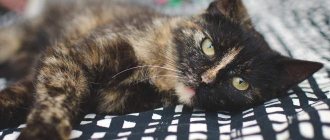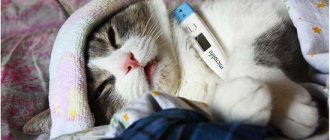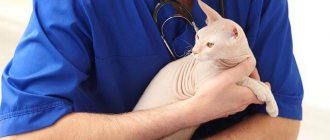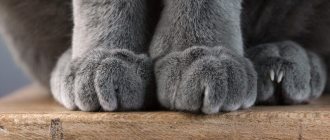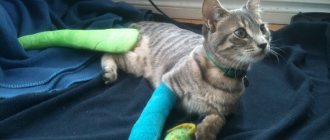Sometimes pet lovers are faced with the following situation: a cat’s back legs have failed. Paralysis or paresis of the limbs is a neurological symptom of serious pathologies of the body. The list of them is very diverse and affects a variety of organs and systems. In the early stages, this condition may be reversible. Therefore, if a cat drags its paw, early contact with a veterinarian significantly increases the likelihood of recovery. One can hope that over time the animal will again feel the joy of movement. From this article you will learn what to do if your pet loses its hind legs, why this can happen and how to help your cat at home.
The importance of differential diagnosis
If a cat's hind legs fail, it is quite difficult to find out the reasons for this. There is a belief that almost all diseases can cause complications and forced limitation of movement.
If a cat does not walk, it can be difficult to distinguish between paralysis of the paws and severe pain that occurs when moving. Perhaps he, experiencing pain when walking, simply refuses to make efforts, since they bring additional discomfort. The causes of severe pain in the back or abdominal area may be the following ailments:
- urolithiasis disease;
- tumor diseases;
- inflammation of the urinary and reproductive system;
- intestinal obstruction.
A distinctive feature of these diseases is that the cat’s paws retain full sensitivity and nerve conduction is not impaired.
Symptoms of pathology
Symptoms may vary depending on the cause of the limb failure. In most cases, the paws do not completely lose their functionality immediately.
At first, the cat may drag its hind limbs and stand on them unsteadily. Without timely treatment, the situation will worsen until the limbs are completely paralyzed. Some diseases can even lead to the death of an animal.
The following symptoms of hind limb failure in a cat can be identified:
- The animal begins to drag its hind legs.
- When walking, the limbs move apart.
- The cat may experience pain and “protect” its hind legs.
- Decreased activity, apathy.
- An increase in body temperature may indicate an inflammatory process in the body or an infection.
- Loss of sensation in the limbs.
- The cat bites its paws.
- Complete failure of the hind limbs. The cat moves only on its front legs, dragging its hind legs behind it.
The main causes of the disease
The main causes of partial or complete paralysis of the hind legs are the following pathologies:
- consequences of spinal injuries and traumatic spinal cord injuries;
- intervertebral disc prolapse;
- inflammatory diseases of the spinal cord;
- arterial thromboembolism;
- fibrocartilaginous embolism;
- vitamin deficiency and potassium metabolism disorders;
- hip dysplasia;
- cardiomyopathy and fibrosis of the heart muscle;
- consequences of stroke;
- nutritional hyperthyroidism;
- consequences of ixodid tick bites.
Consequences of spine and spinal cord injuries
When a cat has a fracture, dislocation of the spine, or severe contusion of the spinal cord, a post-traumatic reaction often occurs - the hind legs are taken away. Paw paralysis may be accompanied by painful shock, loss of consciousness, and fecal and urinary incontinence. With proper treatment and the absence of complications, the animal’s condition is usually reversible and after restoration of nerve conduction, sensitivity gradually returns.
Such serious pathologies are treated in most cases in the clinic surgically. Additionally, the doctor prescribes anti-inflammatory, healing and painkillers (Traumel, Milgamma, Baralgin).
Herniated disc
A herniated disc is a protrusion of a disc between the vertebral bodies. Characterized by pain, muscle tension and limited movement. In severe cases, a herniated disc can cause compression of blood vessels, nerve roots and the spinal cord, in which conductivity gradually deteriorates. Because of this, the innervation of the limbs is disrupted, and they can become paralyzed.
If a cat's legs are paralyzed due to this disease, then painkillers, muscle relaxants that relieve severe muscle spasms, decongestants, and vitamins that improve the condition of nerve fibers are prescribed as treatment.
Spinal cord inflammation
The cause of inflammation of the spinal cord (myelitis) can be injuries, complications of infections, helminthic infestations, and poisoning with toxic substances. Such pathologies are usually accompanied by gastrointestinal disorders, severe fever, feelings of anxiety and fear, nausea and vomiting. In addition, the cat's hind legs gradually fail. With myelitis, the condition is usually reversible and after the inflammation is relieved, the animal's limbs regain sensitivity over time.
Treatment consists of prescribing antibiotics, anti-inflammatory drugs, and muscle relaxants. Physiotherapeutic procedures have a good effect.
Arterial thromboembolism
Arterial thromboembolism of the femoral artery is a blockage of the artery by an embolus (a foreign particle circulating through the bloodstream). An embolus can be a particle of clotted blood (thrombus), a parasite, or a piece of tumor. Thromboembolism disrupts the blood circulation in the paws.
The cat does not feel the bloodless limbs; they gradually become cold. The animal screams in pain, refuses to eat and drink, and prefers to be in dark places. The disease often has a poor prognosis, since the likelihood of cure is very low. But in rare cases, with early diagnosis and proper treatment, the disease recedes.
If sensitivity is at least slightly preserved and there is hope, then the animal is given a paw massage, anticoagulants (reducing blood clotting) and physiotherapeutic procedures are prescribed.
Fibrocartilaginous embolism
With fibrocartilaginous embolism, a thrombus clogs the vessels of the spinal cord. Bleeding tissues gradually become necrotic. Severe pain is replaced by a complete lack of sensitivity. Subsequently, the cat's front and hind legs fail. If the blockage of the vessel is incomplete, then the paralysis of the limbs will be partial and then a cure is possible. The main treatment tactics are the prescription of anticoagulants and physical therapy.
Vitamin deficiency and potassium metabolism disorders
A lack of vitamins and minerals in the body that affect the condition of the limbs and their functions can cause paralysis or paresis of the paws. The probable cause of vitamin deficiency is helminthiasis or a poor cat diet. A lack of vitamins A and B1 is especially dangerous. Lack of sunlight can lead to vitamin D deficiency and, as a result, rickets, which is more common in kittens. With paresis, a lack of potassium in the body is often diagnosed.
Vitamin deficiency and micronutrient deficiency can be easily eliminated. After deworming, restoration of a nutritious diet and a course of vitamin therapy, the cat will regain the ability to move independently.
Hip dysplasia
Hip dysplasia is a congenital pathology of the development of the joint, which greatly increases the likelihood of subluxation and dislocation of the femoral head. The disease develops as a result of genetic predisposition or intrauterine developmental defects. Young animals are more susceptible to it. There is also a breed predisposition (Maine Coon cats are more often affected).
This disease is not associated with loss of sensation and paralysis. The animal cannot walk due to a joint malformation. The main symptoms of the disease are:
- limb weakness;
- inability to jump;
- tilting to the side of the affected joint, frequent falls;
- unsteady gait.
The therapy consists of limiting the cat's movement in order to reduce the load on the sore paws and prescribing special food containing glucosamine and chondroetin, as a building material for the cartilage tissue of the joints.
Cardiomyopathy and fibrosis of the heart muscle
Cardiomyopathy is a group of myocardial diseases caused by dystrophic and sclerotic changes in cardiac cells - cardiomyocytes. It often leads to thickening of the heart walls and decreased volume of the ventricles, causing the heart to pump less blood. The animal begins to suffer from oxygen starvation. Main symptoms:
- dyspnea;
- decreased physical activity;
- cough and vomiting;
- refusal to eat.
Paralysis of the hind legs is not typical for cardiomyopathy, but as a secondary disease, thromboembolism can develop, which is the direct cause of paralysis. In addition, the cat is often unable to move due to severe weakness.
Cardiomyopathy can be a form of fibrosis of the heart muscle. Fibrosis is the proliferation of connective tissue and the appearance of scars on organs. Cardiac fibrosis is an irreversible process. The main goal of therapy is to stop the development of the process and treat the underlying disease.
The main drugs used for cardiomyopathy are beta blockers (Atenolol, Propranolol); calcium channel blockers (Diltiazem), which relieve stress on the heart muscle.
Consequences of a stroke
A stroke in cats can be accompanied by a number of symptoms, including paralysis of not only the limbs, but also other parts of the body. For example, impaired swallowing and breathing function. In addition, loss of consciousness, disorientation, and shock are typical. Whether the animal can be saved depends on how quickly medical assistance is provided. In severe cases, paralysis of all muscles is possible. The sooner the improvement occurs, the more favorable the prognosis for recovery.
Nutritional hyperparathyroidism
The disease is a metabolic disorder in which, due to an unbalanced diet, the body develops a lack of calcium, vitamin D and an increased content of phosphorus. As a result, the parathyroid gland secretes too much so-called parathyroid hormone. The main symptoms of hyperparathyroidism relate to the structure and function of the limbs, including:
- lameness;
- bone deformation;
- pathological fractures;
- strong pain;
- cramps of the hind limbs.
The cat's legs spread apart when walking, and eventually she gives up trying to walk.
The main treatment is to limit the cat’s ability to move and switch to a nutritious diet that replenishes the deficiency of important microelements. The prognosis is usually favorable; after recovery, the feeling of numbness in the legs gradually disappears.
Consequences of tick bites
Numerous ixodid tick bites are very dangerous for cats. They carry with them many dangerous diseases: piroplasmosis, tularemia, encephalitis. Not least of all is tick paralysis.
Tick paralysis occurs when poisoned by insect toxins, if the animal is attacked by several individuals at once. Main symptoms: agitation, anxiety, which turns into apathy and indifference. At this stage, paralysis of the limbs may also occur. Treatment is effective only in the early stages of the disease.
To protect the animal, it is necessary to periodically treat it with special anti-tick drops. In addition, you need to know how to get rid of an embedded tick yourself if medical help is not available:
- Treat the area where the insect has attached itself, lubricate it with an airtight liquid (oil, cream). A choking tick will significantly weaken its grip.
- Using tweezers and a magnifying glass, first remove the head and then, in pairs, the legs of the insect from the skin.
- Lubricate the tick with oil again, and after a while, using a loop made of thin thread, pull out the insect. Treat the cat's bleeding wound.
What to do
It must be emphasized that when cats' back legs begin to fail, it means that something is happening to their body, and it can be quite serious.
Causes can range from simple constipation to cancer and fracture. Whatever the origin of the disease, only a veterinarian can make the correct diagnosis and possible treatment.
You can examine their feet, toes, pads, and nails for damage. While you are investigating the cause of the disease, keep an eye on where it lies to prevent it from getting worse. Make sure there are no dangerous items or toxic substances in the environment that could worsen the condition.
Once the diagnosis is confirmed, your role will be to give him enough attention and care so that he recovers as quickly as possible.
Diagnosis of paw paralysis
If the initial examination is not enough to determine the cause of paw paralysis, then the following diagnostic methods are used:
- determination of neurological reactions;
- X-ray of the spine and affected limbs;
- Ultrasound of the abdominal cavity;
- detailed blood and urine analysis;
- taking smears for bacteriological analysis;
- MRI and CT scans of areas of the body where pathology is suspected to exist (spine, abdominal cavity, brain);
- determining the level of sensitivity of the affected limbs.
Treatment and care
As a result of a comprehensive study, the doctor will give the animal a diagnosis, on which the further treatment plan will depend.
Depending on the disease that caused the paw failure, the following treatment methods for the cat are possible:
- Conservative.
- Operational.
- Physiotherapy.
Conservative method
Most diseases in the early stages can be cured with medication. If an infection is detected, the cat is prescribed antibiotics.
For dysplasia, painkillers and anti-inflammatory drugs are used. In some cases, drug treatment is effective against blood clots.
When a tick bites, antibiotics, diuretics and anticonvulsants are prescribed.
Often the animal is prescribed a diet. It is especially important to follow it if a cat is diagnosed with vitamin deficiency. In this case, vitamin-mineral complexes are also additionally prescribed.
It is important to control the weight of animals that suffer from hip dysplasia or arthritis. Obesity leads to deterioration of the cat's condition.
Surgery
Surgeries are performed in cases of closed and open spinal fractures. Surgical intervention is necessary to remove intervertebral hernias and neoplasms. It is also effective in case of blockage of blood vessels by a blood clot.
Rehabilitation and physiotherapy
Often, in order to restore mobility to paralyzed limbs, the animal must undergo a course of physical therapy. It should only be used as prescribed by a doctor. Otherwise, physical activity may worsen the animal's condition.
Often during rehabilitation the animal is prescribed a special massage. There are also a number of exercises that the owner should do with his pet:
- The paws can be developed using the “bicycle” exercise. Use your hands to carefully move your limbs back and forth.
- You should stroke and tickle the paw pads several times a day.
- Place a towel under the cat's belly. You need to take it by both ends and carefully lift the animal. The cat will try to walk forward by moving its hind legs.
General restorative home treatments for paralysis of paws
If a cat's hind legs have failed, he will benefit from daily restorative procedures. The owner can easily work with the pet on his own at home.
- Paw massage should be done 5 to 7 times a day. For 10-15 minutes, massage your limbs with light but intense movements. This will help restore the conduction of nerve impulses and prevent the muscles from atrophying.
- Therapeutic gymnastics in the form of forced flexion and extension of the limbs is very useful.
- You can imitate walking using a kind of walker, which can be made from a wide towel placed under the cat’s belly. By supporting the animal in this way, you need to provoke it to move its paws on its own. If it is difficult for him, you can help with your hands.
- Swimming gives very good results if the cat is not afraid of water. Once in a pond or bathtub, the animal involuntarily moves its paws, trying to swim, while the owner holds it under its belly. It has been noticed that healing occurs much faster after a course of such exercises.
- Tickling the paws will help the owner feel the moment when the animal begins to feel them, by reaction to irritation.
- Exercises on the ball are effective. The cat is placed on a ball of suitable size. Her paws, hanging down, should almost touch the floor, so that when she rolls, she seems to stand on them.
If the cat’s treatment does not bring the expected effect, and it still drags its hind legs, then you should not euthanize the animal. There is a way out in this case too. There are specialized wheelchairs for cats that perform the functions of limbs. Once accustomed, the cat will be able to move quite quickly in such a stroller without the help of the owner. The quality of life of an animal when using such a device remains quite high.
First aid at home
If the hind limbs fail, the cat should be seen by a doctor as soon as possible. First of all, you need to take the following measures:
- If the animal is panicking, it should be calmed down. You can talk to the cat in a gentle voice, stroke its head. It is important that the animal moves as little as possible.
- If trauma has led to paralysis, the cat must be fixed in one position. This should be done carefully so that the cat does not get nervous and try to escape. There should be a hard, hard surface underneath the animal. All movements should be kept to a minimum.
- If your limbs start to get cold, you can put a heating pad under them. It should not be very hot to avoid burns.
- If the animal is vomiting severely, the cat should be placed on its side so that the vomit does not clog the airways.
- If the cat has definitely not been injured, it can be placed on a soft surface (put a blanket in the carrier).
You need to take your animal’s veterinary passport with you to the clinic. Disposable diapers and clean napkins will not hurt. If it is cold outside, the animal should be covered.
Diagnostics
There can be many reasons for hind leg failure in cats. If the owner himself has not witnessed the injury that the cat received, a large-scale diagnosis will have to be carried out.
At the clinic, the veterinarian will conduct the following tests:
- Take a general urine and blood test. They can be used to determine the presence of inflammatory processes in the body.
- Conducts an external inspection. Test the sensitivity of the limbs and reflexes.
- Take an x-ray of the spine. It shows the presence of fractures, tumors, and dislocations.
- It is possible to take an x-ray using contrast fluid.
- If an infection is suspected, the doctor may take a bacterial culture.
- If damage to internal organs is suspected, the doctor will perform an ultrasound.
- If necessary, an MRI of the brain and spine can be done.
We recommend the article: Albino cats: features of appearance, health and character
Cardiomyopathy, stroke
An increase in the volume of the heart or thickening of its walls (cardiomyopathy) sharply leads to paralysis of the limbs. But this still happens. The cause is a lack of oxygen reaching the muscles. Associated symptoms of the disease are shortness of breath, drowsiness of the animal, cough, and apathetic state. Since heart surgery cannot be performed on cats, treatment will be conservative. Veterinarians often prescribe Diltiazem or Atenolol, and complete rest is recommended for the animal.
Sometimes the cause of limb paralysis is a stroke. It often occurs in old or sedentary animals. Treatment is possible only with the assistance of an experienced veterinarian. He will prescribe antipsychotics, painkillers and anti-convulsions medications.
Physiotherapy for cats with leg paralysis
The recovery period after paralysis drags on for a long time; in this case, the animal owner cannot do without physiotherapy.
Veterinarians advise performing a daily set of exercises to help restore neurological functions.
- Passive movements. Place the cat on its back and move the paralyzed legs alternately in a circular motion for at least five minutes. The exercise is similar to riding a bicycle.
- Stimulating massage. Stretch your paw pads and limbs daily.
- Scratching. Scratch the paralyzed animal in different places; even with little progress, the cat will try to scratch with its hind paw.
- Using an inflatable ball. Place the cat on its stomach on the ball, so that its paws lightly touch the floor. Roll the ball while holding your pet back and forth.
- Using support. Pass a wide strip of fabric under your pet's belly and try to walk with the animal, holding the ends of the fabric.
- Moving limbs. Take the cat by the hind legs and slowly move them, imitating walking.
- Swimming. Make the cat swim in the bath every day, holding the animal so that it does not choke.
Interesting Facts
An interesting experiment was unintentionally and accidentally carried out in one of the nurseries. A rare breed was being bred, and the mother cat refused to feed her offspring. Six blind newborn kittens were divided into two groups. The three were fed by a diligent laboratory assistant. She wrapped each kitten in a napkin so that it wouldn’t get dirty, picked it up and fed it milk from a pacifier.
The second group was raised by a trainee. He simply placed three bottles sideways on the bottom of the box and went about his business. After two months, a difference in the physical development of the pets became noticeable. Those babies who received food without making any special effort, without moving their paws, without massaging the bottles, turned out to be non-viable. The sad end of the experiment showed the benefit of the reflex. Among other things, it strengthens the kitten’s muscles and develops it physically.
Methodology
When performing a massage of the hind legs of cats, it is recommended to combine massage techniques with periodic flexion and extension of the joints.
Helpful advice! During the massage, the animal should be calm and relaxed. However, many cats do not like to have their thighs or paw pads touched - these are particularly sensitive areas. Therefore, during the first few days, you should limit yourself to stroking and lightly rubbing the hind legs, without allowing your cat to show obvious displeasure from the procedure.
The massage procedure is as follows:
- Perform a series of strokes, starting from the back of the animal and ending with the hind legs.
- Take the cat's hind paw in your hand and lightly massage the paw pad and each toe of the hind leg with vibrating movements.
- Knead the muscles and tendons located around the wrist joint, bend and straighten the joint several times.
- Then, using circular rubbing movements, moving towards the base of the paw, reach the hock joint.
- From the hock to the knee joint, alternate the “kneading” and “stroking” techniques; this is the main time-consuming part of the massage.
- Gently bend and straighten the knee joint several times, while simultaneously stretching its muscles.
- Massage your thigh in a circular motion, alternating between stroking and kneading.
- You can perform tapping on the soft tissues of the thigh using bent fingers.
- Finish the paw massage with slow, deep stroking.
- Massage the other paw in the same way.
- Pet your cat and praise him.
If you perform the massage correctly, your pet will receive not only benefits from this procedure, but also pleasure. When touched by the owner's hands, the cat will purr, close its eyes and press its body to the hands.
You can also contact our site's staff veterinarian, who will respond to them as soon as possible in the comment box below.
Massage technique for a cat on video:
Misconceptions
Sometimes “experts” in cat psychology explain their behavior by saying that by massaging something or someone, they receive psychological relief, and endorphins are produced in the body. But, excuse me, when a person experiences pleasure from food, affection or sex, doesn’t he release a hormone of joy? This version puts the cart before the horse and confuses effect and cause.
Don’t believe it when, when answering the question why cats knead us with their paws and purr, they tell you about therapeutic massage. Yes, the living warmth of an affectionate cat heals, relieves spasms, even nervous tension. Yes, she often chooses sore spots with elevated temperatures to snuggle and warm up. But Murkas do their “massage” not on the owner’s problem areas, but where it is convenient for them.
Observing cats at home, we notice that they, sensitively sensing and choosing warm places, are completely indifferent to the softness of the sleeping place. Therefore, the hypothesis that they trample the future rookery to make it softer can also not be considered.
We invite you to read: Pyrantel for cats and methods of treating parasitic infections
